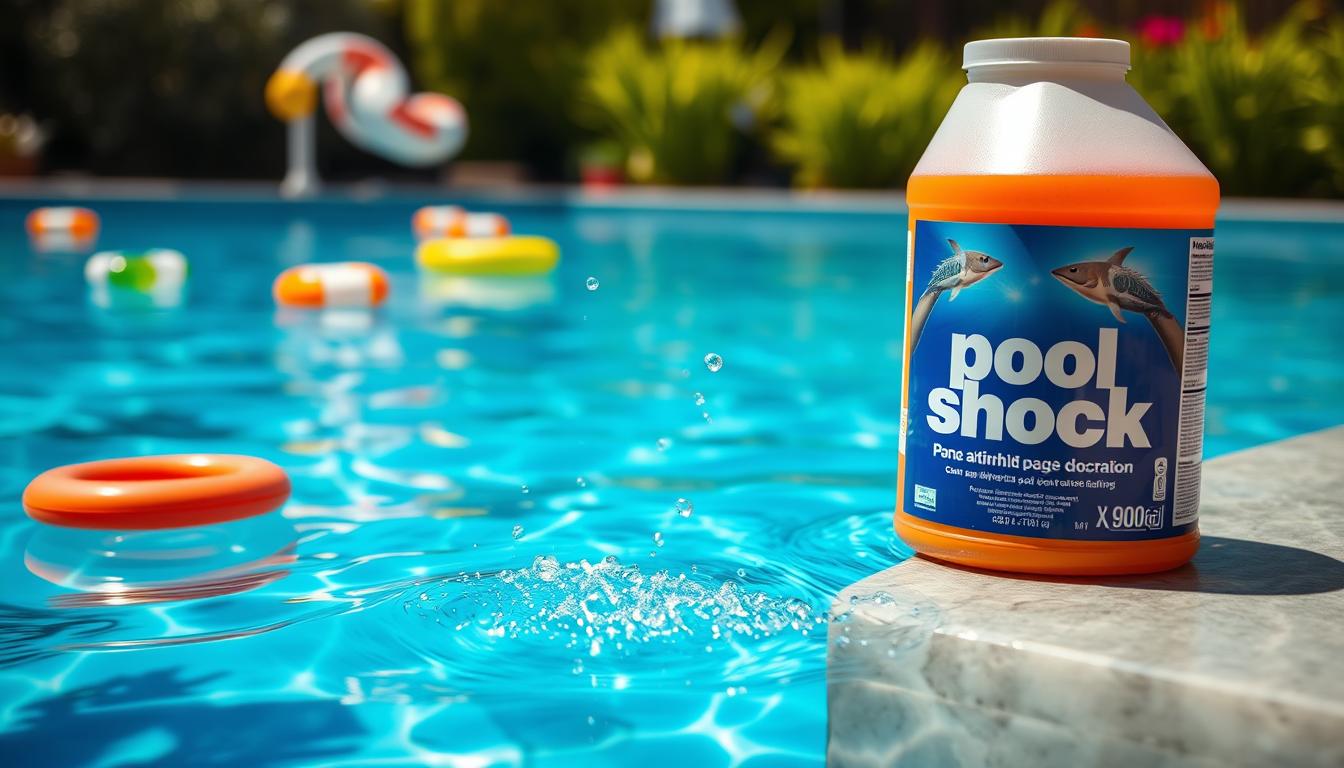
Pool shock is vital for keeping your swimming pool clean and safe. It’s a powerful treatment, but its timeline can be puzzling. Let’s explore how pool shock works and how long it takes to be effective.
We’ll look at the factors that influence its performance. This guide will help you understand pool shock treatment better.
Pool shock is a strong chlorine or non-chlorine solution. It quickly sanitizes your pool water by boosting “free chlorine” levels. This process kills algae, bacteria, and other harmful contaminants.
The result is crystal-clear, safe water for swimming. Pool shock is a key part of maintaining a healthy pool environment.
Key Takeaways
- Pool shock is a powerful chemical treatment that rapidly raises chlorine levels to combat algae and bacteria.
- The general rule is to wait at least 24 hours before swimming after shocking your pool to avoid skin and eye irritation.
- The amount of shock needed depends on pool size, current chlorine levels, and the specific shock product used.
- Factors like sunlight, water temperature, and bather load can impact the effectiveness and duration of pool shock treatment.
- Regular shocking, along with proper pool maintenance, is essential for maintaining a safe and clean swimming environment.
What is Pool Shocking and Why is it Important?
Pool shocking is adding a high dose of chlorine to the water. It’s vital for keeping your pool clean and safe. This process kills harmful bacteria, algae, and other contaminants in the water.
Regular shocking ensures crystal clear, odor-free water. It makes the pool inviting for swimmers. You’ll have a healthier swimming environment by shocking your pool often.
Understanding the Shocking Process
Pool shocking raises free chlorine levels in the water. This destroys unwanted organisms and neutralizes organic compounds. The shock treatment quickly dissolves and spreads throughout the water.
This process also breaks down chloramines. These compounds form when chlorine mixes with sweat and oils. Chloramines cause the “chlorine smell” in poorly maintained pools.
Maintain the right chemical balance for optimal pool sanitization. Ideal chlorine levels should be 1.0-4.0 ppm. The pH level should stay between 7.2 and 7.8.
Benefits of Regularly Shocking Your Pool
Regular pool shocking offers many benefits. It improves water clarity and enhances pool disinfection. Shocking also reduces chloramine levels and prevents algae growth.
| Benefit | Description |
|---|---|
| Improved water clarity | Shocking helps to eliminate cloudy water caused by contaminants, resulting in a crystal-clear pool. |
| Enhanced pool disinfection | By destroying bacteria and other harmful organisms, shocking ensures a more hygienic swimming environment. |
| Reduced chloramine levels | Shocking breaks down chloramines, minimizing unpleasant odors and reducing eye and skin irritation for swimmers. |
| Preventative maintenance | Regular shocking helps prevent the growth of algae and other contaminants, making pool maintenance easier in the long run. |
Shock your pool every one to two weeks. Factors like pool size, swimmer count, and environment affect frequency. Heavily used pools may need more frequent shocking.
Always shock after heavy use or during extreme heat. This keeps your pool water quality at its best. Regular shocking makes pool maintenance easier in the long run.
Types of Pool Shock and Their Effectiveness
Choosing the right pool shock is key to a clean, healthy swimming pool. Different types offer unique benefits. Let’s explore calcium hypochlorite, dichlor, and non-chlorine shock.
Calcium Hypochlorite: The Most Common Pool Shock
Calcium hypochlorite is widely used for its high chlorine content and affordability. It delivers 68% available chlorine, making it highly potent. This shock needs dissolving before use and works best when applied in the evening.
Dichlor: A Stabilized Chlorine Option
Dichlor is a stabilized chlorine that dissolves quickly in water. It provides 56% available chlorine and suits various pool types. Dichlor doesn’t need pre-dissolving and lasts longer, making it great for sunny conditions.
Non-Chlorine Shock: Ideal for Sensitive Swimmers
Non-chlorine shock uses potassium monopersulfate to clean water without raising chlorine levels. It’s perfect for people with chlorine sensitivities. This shock allows for swimming almost immediately after treatment.
| Type of Shock | Active Ingredient | Available Chlorine | Ideal For |
|---|---|---|---|
| Calcium Hypochlorite | Calcium Hypochlorite | 68% | Most common, affordable, and effective |
| Dichlor | Dichloroisocyanuric Acid | 56% | Saltwater pools, vinyl liner pools, and pools exposed to direct sunlight |
| Non-Chlorine Shock | Potassium Monopersulfate | N/A | Sensitive swimmers and immediate swimming after treatment |
Knowing these pool shock types helps you choose the best for your needs. Regular shocking keeps your pool water clear and safe. Your choice depends on your pool’s specific requirements and your preferences.
How Long Does it Take for Pool Shock to Work?
Pool shock working time varies based on factors like shock type, amount used, and pool size. Wait at least 24 hours after shocking before swimming. This allows chlorine levels to stabilize, ensuring safe water for swimmers.
Check chlorine levels with a test kit before entering the pool. Ensure levels are under 4 parts per million (ppm). A general rule is to wait an hour per pound of shock added.
Chlorine-based shock is common for resetting pool water. Chlorine-free shock is a gentler alternative that oxidizes water. Non-chlorine shock allows swimming within 15 minutes, while chlorine shock needs more time.
Swimming too soon after shocking can cause skin and eye irritations. High chlorine levels may lead to nausea and vomiting if ingested. Freshly shocked pools can discolor clothing and swimwear.
Maintain a balanced pH level, ideally 7.2-7.4, before shocking for best results. CYA levels affect pH, impacting chlorine and pool shock effectiveness.
Always test chlorine levels before swimming. Ensure they’re between 1.0 to 4.0 ppm for safety. Following these guidelines helps maintain a clean, safe swimming environment.







